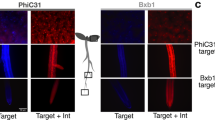Abstract
Tetracycline-regulated gene expression in eukaryotic cell lines, plants, and transgenic mice has become a powerful tool for the analysis of eukaryotic gene expression and function. The system consists of two plasmids, one encoding the transactivator protein under control of a viral cytomegalovirus promoter, and the second being the fef-operator minimal promoter driving the gene of interest. Here we show that these control elements, when integrated in cis on a single plasmid, allow efficient and tight control of reporter gene expression in vitro and in vivo. Dependent on the route of administration of tetracycline, gene expression can be partially or fully repressed in transgenic mice, whereas removal of the antibiotic induces the reporter gene in various tissues to levels up to 800-fold more than the two-plasmid system. In addition, crossing and analysis of animals transgenic for the individual components of the system are unnecessary, and genetic segregation of the control elements during breeding is prevented.
This is a preview of subscription content, access via your institution
Access options
Subscribe to this journal
Receive 12 print issues and online access
$209.00 per year
only $17.42 per issue
Buy this article
- Purchase on Springer Link
- Instant access to full article PDF
Prices may be subject to local taxes which are calculated during checkout
Similar content being viewed by others
References
Yarranton, G.T. 1992. Inducible vectors for expression in mammalian cells. Curr. Opin. Biotech. 3: 506–511.
Hu, M.C. and Davidson, N. 1987. The inducible lacoperator-represser system is functional in mammalian cells. Cell 48: 555–566.
Gossen, M., Bonin, A.L. and Bujard, H. 1993. Control of gene activity in higher eukaryotic cells by prokaryotic regulatory elements. Trends Biol. Sci. 18: 471–475.
Gossen, M. and Bujard, H. 1992. Tight control of gene expression in mammalian cells by tetracycline-responsive promoters. Proc. Natl. Acad. Sci. USA 89: 5547–5551.
Shan, B. and Lee, W.H. 1994. Deregulated expression of E2F-1 induces S-phase entry and leads to apoptosis. Mol. Cell Biol. 14: 8166–8173.
Resnitzky, D., Gossen, M., Bujard, H. and Reed, S.I. 1994. Acceleration of the G1/S phase transition by expression of cyclins D1 and E with an inducible system. Mol. Cell Biol. 14: 1669–1679.
Damke, H., Baba, T., Warnock, D.E. and Schmid, S.L. 1994. Induction of mutant dynamin specifically blocks endocytic coated vesicle formation. J. Cell Biol. 127: 915–934.
Fruh, K., Gossen, M., Wang, K., Bujard, H., Peterson, P.A. and Yang, Y. 1994. Displacement of housekeeping proteasome subunits by MHC-encoded LMPs: a newly discovered mechanism for modulating the multicatalytic proteinase complex. EMBO J. 13: 3236–3244.
Howe, J.R., Skryabin, B.V., Belcher, S.M., Zerillo, C.A. and Schmauss, C. 1995. The responsiveness of a tetracycline-sensitive expression system differs in different cell lines. J. Biol. Chem. 270: 14168–14174.
Weinmann, R., Gossen, M., Hillen, W., Bujard, H. and Gatz, C. 1994. A chimeric transactivator allows tetracycline-responsive gene expression in whole plants. Plant J. 5: 559–569.
Furth, P.A., St Onge, L., Boger, H., Gruss, P., Gossen, M., Kistner, A., Bujard, H. and Hennighausen, L. 1994. Temporal control of gene expression in transgenic mice by a tetracycline-responsive promoter. Proc. Natl. Acad. Sci. USA 91: 9302–9306.
Passman, R.S. and Fishman, G.I. 1994. Regulated expression of foreign genes in vivoafter germline transfer. J. Clin. Invest. 94: 2421–2425.
Efrat, S., Fuscodemane, D., Lemberg, H., Alemran, O. and Wang, X.R. 1995. Conditional transformation of a pancreatic beta-cell line derived from transgenic mice expressing a tetracycline-regulated oncogene. Proc. Natl. Acad. Sci. USA 92: 3576–3580.
Sande, M.A. and Mandell, G.L., 1990. Tetracycline, chloramphenicol, erythro-myvin and miscellaneous antibiotic agents, pp. 1117–1125 in The Pharmacological Basis of Therapeutics. Gilman, A. G., Rail, T. W., Nies, A. S., and Taylor, P. (eds.). Pergamon Press, New York.
Shockett, P., Difilippantonio, M., Hellman, N. and Schatz, D.G. 1995. A modified tetracycline-regulated system provides autoregulatory, inducible gene expression in cultured cells and transgenic mice. Proc. Natl. Acad. Sci. USA 92: 6522–6526.
Deuschle, U., Meyer, W.K.H. and Thiesen, H.J. 1995. Tetracycline-reversible silencing of eukaryotic promoters. Mol. Cell Biol. 15: 1907–1914.
Gossen, M., Freundlieb, S., Bender, G., Muller, G., Hillen, W. and Bujard, H. 1995. Transcriptional activation by tetracyclines in mammalian cells. Science 268: 1766–1769.
Hogan, B., Costantini, F. and Lacy, E. 1986. Manipulating the Mouse Embryo: A Laboratory Manual.Cold Spring Harbor Laboratory Press, New York.
Author information
Authors and Affiliations
Rights and permissions
About this article
Cite this article
Schultze, N., Burki, Y., Lang, Y. et al. Efficient control of gene expression by single step integration of the tetracycline system in transgenic mice. Nat Biotechnol 14, 499–503 (1996). https://doi.org/10.1038/nbt0496-499
Received:
Accepted:
Issue Date:
DOI: https://doi.org/10.1038/nbt0496-499
This article is cited by
-
Synergistic effects of deleting multiple nonessential elements in nonreplicative HSV-1 BAC genomic vectors play a critical role in their viability
Gene Therapy (2017)
-
The transgenic cloned pig population with integrated and controllable GH expression that has higher feed efficiency and meat production
Scientific Reports (2015)
-
In vivo genome editing using nuclease-encoding mRNA corrects SP-B deficiency
Nature Biotechnology (2015)
-
Doc2b enrichment enhances glucose homeostasis in mice via potentiation of insulin secretion and peripheral insulin sensitivity
Diabetologia (2014)
-
Sustained leukaemic phenotype after inactivation of BCR-ABLp190 in mice
Oncogene (2007)



